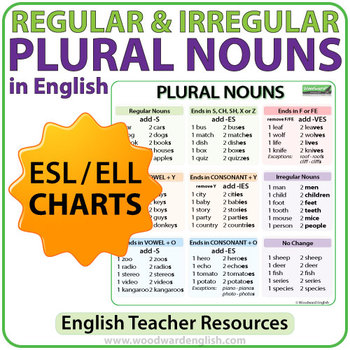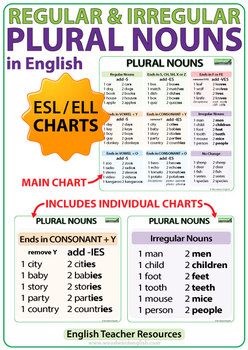Plural Nouns Charts - Regular & Irregular Nouns in English
Woodward Education
2.9k Followers
Grade Levels
1st - 4th, Homeschool
Subjects
Resource Type
Standards
CCSSL.2.1b
Formats Included
- PDF
Pages
10 pages
Woodward Education
2.9k Followers
What educators are saying
My students loved using this resource, It was engaging and I will purchase from this seller in the future!
I utilize this resource to help my EL students to understand how the English language is used. Language acquisition can be difficult to comprehend. Having the right tools to assist in the learning process makes a great difference.
Description
Regular and Irregular Nouns in English - Summary Charts
These charts look at the spelling rules used when making nouns plural. They cover both regular and irregular plural forms.
Plurals Summary Chart
This chart is a summary of the nine spelling rules that appear below, all in one handy place. It is great as a quick reference guide for students.
Regular Nouns
Nouns where we add an -S to make them plural. There are no other changes to the noun. The example nouns are car, dog, book, house, and apple.
Nouns ending in S, CH, SH, X, Z
Nouns with these endings and where we need to add -ES to make them plural. The example nouns are bus, match, dish, box, and quiz.
Nouns ending in F or FE
Nouns with these endings and how we remove them and add -VES to make the nouns plural. The example nouns are leaf, wolf, life, and knife. There are two exceptions to this rule that also appear in this chart: roofs and cliffs.
Nouns ending in VOWEL + Y
These are regular nouns where we just add the -S to the plural. The example nouns are day, key, boy, guy, and donkey. This chart exists to be able to compare it with the next chart about nouns ending in a consonant + Y.
Nouns ending in CONSONANT + Y
We remove the end Y and add -IES to these nouns to make them plural. The example nouns are city, baby, story, party, and country.
Irregular Nouns
These are nouns that have a completely different plural form compared to its singular form. The example nouns are man, child, foot, tooth, mouse, and person.
Nouns ending in VOWEL + O
These are regular nouns where we just add the S to make them plural. The example nouns are zoo, radio, stereo, video, and kangaroo. This chart exists to be able to compare it with the next chart about nouns ending in a consonant + O.
Nouns ending in CONSONANT + O
We add -ES to these nouns to make them plural. The example nouns are hero, echo, tomato, and potato. We also show some exceptions to the rule where we only add an -S. These words are piano and photo.
Nouns that don't change in plural
These are the nouns that have the same form in singular and plural. The example nouns are sheep, deer, fish, series, species
These charts can be used for decorating the classroom wall or as a part of literary centers. Some teachers also photocopy these and make a booklet for students.
CONTENT: This resource contains 10 Pages:
- Plurals Summary Chart - (1 page)
- Regular Nouns - (1 page)
- Nouns ending in S, CH, SH, X, Z - (1 page)
- Nouns ending in F or FE - (1 page)
- Nouns ending in VOWEL + Y - (1 page)
- Nouns ending in CONSONANT + Y - (1 page)
- Irregular Nouns - (1 page)
- Nouns ending in VOWEL + O - (1 page)
- Nouns ending in CONSONANT + O - (1 page)
- Nouns that don't change in plural - (1 page)
These charts are aligned to Common Core State Standards:
L.K.1C - Form regular plural nouns orally by adding /s/ or /es/ (e.g., dog, dogs; wish, wishes).
L.2.1B - Form and use frequently occurring irregular plural nouns (e.g., feet, children, teeth, mice, fish).
Please download the preview so you can have a better idea of the quality of this resource and what it contains.
Click Follow Me to receive a message whenever we post any new items (and also whenever we have sales).
Have a great day!
- Rob W.
These charts look at the spelling rules used when making nouns plural. They cover both regular and irregular plural forms.
Plurals Summary Chart
This chart is a summary of the nine spelling rules that appear below, all in one handy place. It is great as a quick reference guide for students.
Regular Nouns
Nouns where we add an -S to make them plural. There are no other changes to the noun. The example nouns are car, dog, book, house, and apple.
Nouns ending in S, CH, SH, X, Z
Nouns with these endings and where we need to add -ES to make them plural. The example nouns are bus, match, dish, box, and quiz.
Nouns ending in F or FE
Nouns with these endings and how we remove them and add -VES to make the nouns plural. The example nouns are leaf, wolf, life, and knife. There are two exceptions to this rule that also appear in this chart: roofs and cliffs.
Nouns ending in VOWEL + Y
These are regular nouns where we just add the -S to the plural. The example nouns are day, key, boy, guy, and donkey. This chart exists to be able to compare it with the next chart about nouns ending in a consonant + Y.
Nouns ending in CONSONANT + Y
We remove the end Y and add -IES to these nouns to make them plural. The example nouns are city, baby, story, party, and country.
Irregular Nouns
These are nouns that have a completely different plural form compared to its singular form. The example nouns are man, child, foot, tooth, mouse, and person.
Nouns ending in VOWEL + O
These are regular nouns where we just add the S to make them plural. The example nouns are zoo, radio, stereo, video, and kangaroo. This chart exists to be able to compare it with the next chart about nouns ending in a consonant + O.
Nouns ending in CONSONANT + O
We add -ES to these nouns to make them plural. The example nouns are hero, echo, tomato, and potato. We also show some exceptions to the rule where we only add an -S. These words are piano and photo.
Nouns that don't change in plural
These are the nouns that have the same form in singular and plural. The example nouns are sheep, deer, fish, series, species
These charts can be used for decorating the classroom wall or as a part of literary centers. Some teachers also photocopy these and make a booklet for students.
CONTENT: This resource contains 10 Pages:
- Plurals Summary Chart - (1 page)
- Regular Nouns - (1 page)
- Nouns ending in S, CH, SH, X, Z - (1 page)
- Nouns ending in F or FE - (1 page)
- Nouns ending in VOWEL + Y - (1 page)
- Nouns ending in CONSONANT + Y - (1 page)
- Irregular Nouns - (1 page)
- Nouns ending in VOWEL + O - (1 page)
- Nouns ending in CONSONANT + O - (1 page)
- Nouns that don't change in plural - (1 page)
These charts are aligned to Common Core State Standards:
L.K.1C - Form regular plural nouns orally by adding /s/ or /es/ (e.g., dog, dogs; wish, wishes).
L.2.1B - Form and use frequently occurring irregular plural nouns (e.g., feet, children, teeth, mice, fish).
Please download the preview so you can have a better idea of the quality of this resource and what it contains.
Click Follow Me to receive a message whenever we post any new items (and also whenever we have sales).
Have a great day!
- Rob W.
Total Pages
10 pages
Answer Key
Does not apply
Teaching Duration
N/A
Report this resource to TPT
Reported resources will be reviewed by our team. Report this resource to let us know if this resource violates TPT’s content guidelines.
Standards
to see state-specific standards (only available in the US).
CCSSL.2.1b
Form and use frequently occurring irregular plural nouns (e.g., feet, children, teeth, mice, fish).



